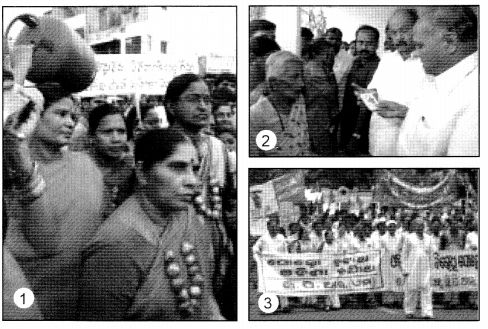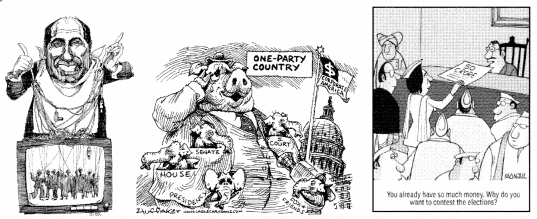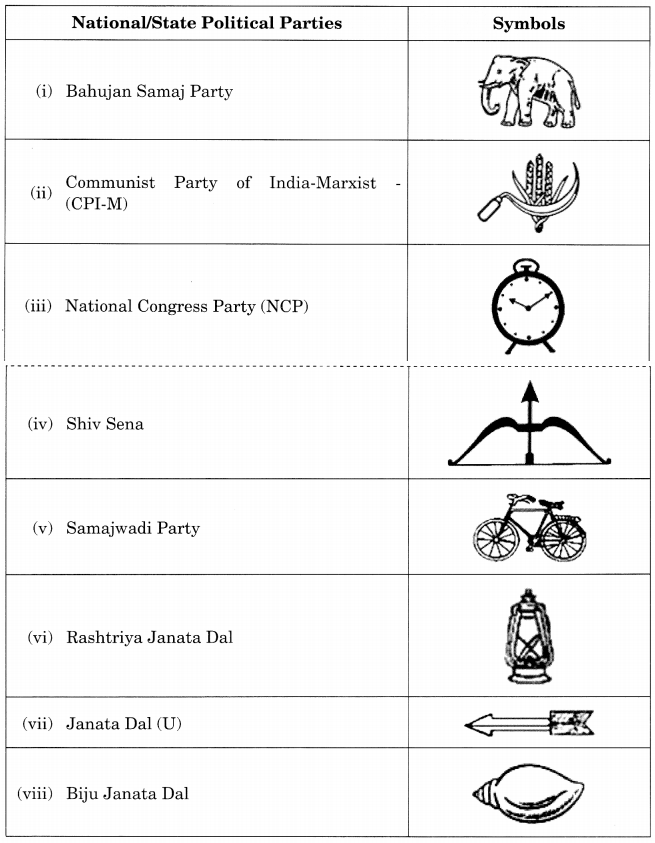WELCOME TO PROMISEDPAGE
SMART LEARNING BLOG
HOME
Sunday, August 3, 2025
Saturday, September 28, 2024
Political Parties Class 10 MCQs Questions with Answers
Choose the correct option:
Question 1.
Which one of the following facilities is offered by the Election Commission to
a recognised political party?
(a) Party name
(b) Election funds
(c) Election symbol
(d) Manifesto
Answer
Answer: (c) Election symbol
Question 2.
Which one of the following is a ‘National Political Party’?
(a) Samajwadi Party
(b) Rashtriya Janata Dal
(c) Rashtriya Lok Dal
(d) Bahujan Samaj Party
Answer
Answer: (d) Bahujan Samaj Party
Question 3.
Who among the following recognises political parties in India?
(a) Election Commission
(b) President of India
(c) Speaker of Lok Sabha
(d) Supreme Court
Answer
Answer: (a) Election Commission
Question 4.
Which one of the following countries has one party system?
(a) China
(b) Indo-China
(c) Japan
(d) Germany
Answer
Answer: (a) China
Question 5.
In which of the following states does Shiv Sena exist as a regional political
party?
(a) Gujarat
(b) Karnataka
(c) Maharashtra
(d) Madhya Pradesh
Answer
Answer: (c) Maharashtra
Question 6.
Name the political party that emerged out of mass movement?
(a) DMK
(b) Janata Dal
(c) Forward Bloc
(d) Bahujan Sam
Answer
Answer: (b) Janata Dal
Question 7.
A recognised political party is
(a) a party that is present in only one of the federal units.
(b) a party that is present in several and all units of the federation.
(c) a party that is based on regional and communal diversities.
(d) a party recognised by the ‘Election Commission’ with all the privileges
and facilities.
Answer
Answer: (d) a party recognised by the ‘Election Commission’ with all the privileges and facilities.
Question 8.
An example of a country having the multi party system is
(a) China
(b) USA
(c) India
(d) United Kingdom
Answer
Answer: (c) India
Question 9.
How many parties are needed in any democratic system to compete in elections
and provide a fair chance for the competing parties ; to come to power?
(a) Less than two
(b) At least two parties
(c) More than two parties
(d) At least three parties
Answer
Answer: (b) At least two parties
Question 10.
The number of political parties registered with the Election Commission of
India is
(a) 750 parties
(b) more than 750 parties
(c) Less than 750 parties
(d) 705 parties
Answer
Answer: (b) more than 750 parties
Question 11.
How many parties are registered with the Election Commission of India?
(a) 250
(b) 300
(c) 500
(d) More than 750
Answer
Answer: (d) More than 750
Explanation:
There are a large number of political parties in each country. More than 750
parties are registered with the Election Commission of India.
Question 12.
What is a signed document submitted to an officer regarding her personal
information?
(a) Affidavit
(b) Declaration
(c) Agreement
(d) Appeal
Answer
Answer: (a) Affidavit
Explanation:
An affidavit is a signed document submitted to an officer, where a person
makes a sworn statement regarding her personal information.
Question 13.
Which of these statements is incorrect about CPI (M)?
(a) Supports socialism, secularism and democracy
(b) Opposes imperialism and communalism
(c) Wants to secure socio-economic justice in India
(d) None of the above
Answer
Answer: (d) None of the above
Explanation:
CPI(M) supports socialism, secularism and democracy and opposes imperialism
and communalism. Accepts democratic elections as a useful and helpful means
for securing the objective of socio- economic justice in India.
Question 14.
Who chooses the candidates for contesting elections in India?
(a) Members and supporters of the party
(b) Top party leadership
(c) The existing government
(d) None of these
Answer
Answer: (b) Top party leadership
Explanation:
In other countries like India, top party leaders choose candidates for
contesting elections.
Question 15.
When and under whose leadership was Bahujan Samaj Party (BSP) formed?
(a) 1982, Mayawati
(b) 1984, Kanshi Ram
(c) 1985, Mulayam Singh Yadav
(d) 1986, Bhajanlal
Answer
Answer: (b) 1984, Kanshi Ram
Explanation:
Bahujan Samaj Party (BSP) was formed in 1984 under the leadership of Kanshi
Ram. Seeks to represent and secure power for the bahujan samaj which
includes the dalits, adivasis, OBCs and religious minorities.
Question 16.
When was the BJP founded?
(a) 1960
(b) 1970
(c) 1980
(d) 1990
Answer
Answer: (c) 1980
Explanation:
Bharatiya Janata Party (BJP) was founded in 1980 by reviving the erstwhile
Bharatiya Jana Sangh.
Question 17.
How many recognised national parties were there in 2006?
(a) 5
(b) 6
(c) 7
(d) 8
Answer
Answer: (b) 6
Explanation:
According to the classification, there were six national recognised parties
in the country in 2006
Question 18.
What are the parties which are given the special privilege of ‘election
symbol’ and other facilities?
(a) ‘Identified’ by the Election Commission
(b) ‘Recognised’ by the Election Commission
(c) ‘Patronised’ by the Election Commission
(d) ‘Attached’ by the Election Commission
Answer
Answer: (b) ‘Recognised’ by the Election Commission
Explanation:
Parties that get this privilege and some other special facilities are
‘recognised’ by the Election Commission for this purpose. That’s why these
parties are called, ‘recognised political parties’.
Question 19.
Which of these alliances were there in 2004 parliamentary elections in
India?
(a) National Democratic Alliance
(b) The United Progressive Alliance
(c) Left Front
(d) All the above
Answer
Answer: (d) All the above
Explanation:
In India there were three such major alliances in 2004 parliamentary
elections– the National Democratic Alliance, the United Progressive Alliance
and the Left Front.
Question 20.
Which of these is not a good option for a democratic state?
(a) One-party system
(b) Two-party system
(c) Multi-party system
(d) None of the above
Answer
Answer: (a) One-party system
Explanation:
We cannot consider one-party system as a good option because this is not a
democratic option. Any democratic system must allow at least two parties to
compete in elections and provide a fair chance for the competing parties to
come to power.
Picture-based Questions:
Question 1.
Study at the following photographs from NCERT textbook page 75 and answer the
question that follows:

(i) Activists of BJP Mahila Morcha demonstrate against hike in prices of
onions and LPG in Vishakhapatnam.
(ii) Minister distributes Rs One lakh cheque to the families of hooch victims
at their houses.
(iii) Activists of CPI (M), CPI, OGP and JD (S) take out a rally in
Bhubaneswar to protest against POSCO, the Korean steel company for being
permitted by the State Government to export iron ore from Orissa to feed steel
plants in China and Korea.
Answer
Answer:
- Role of opposition
- Parties provide people access to government machinery and welfare schemes.
- Parties shape public opinion.
Question 2.
Now categorise these photographs by the functions of political parties they
illustrate. Find one photograph or news clipping from your own area for each
of the functions listed above.
Look at the following cartoon from NCERT textbook page 83,84 & 85 and
answer the question that follows:

Can you identify which of the challenges described in this section are being
highlighted in these cartoons? What are the ways to curb the misuse of money
and muscle power in politics?
Answer
Answer:
The challenges highlighted here are about the growing role of money and
muscle power in parties, especially during elections.
Some of the ways to curb the misuse of money and muscle power in politics are:
- There should be state funding of elections. The government should give parties money to support their election expenses.
- Public participation should be increased.
- The Supreme Court order to reduce the influence of money and muscle power should be made strict.
Activity/Project-based Questions:
Give the symbols of the following national and state/regional political parties:
- Bahujan Samaj Party
- Communist Party of India-Marxist – (CPI-M)
- National Congress Party (NCP)
- Assam United Democratic Front
- Samajwadi Party
- Rashtriya Janata Dal
- Janata Dal (U)
- Biju Janata Dal
Answer
Answer:

Political Parties Class 10 Quiz
Please fill the above data!
Name : Apu
Roll : 9
Total Questions:
Correct: | Wrong:
Attempt: | Percentage:
Q1. What is a political party?
A. Self made groups who automatically hold power
B. A group of people who come together to contest elections and hold power in the government
C. Non government groups to do social work
D. Government organisations for social work
Q2. Parties are about a part of the society and thus involve …………….?
A. Partnership
B. Participation
C. Partisanship
D. Political partnership
Q3. What are the components of a political party?
A. Leaders
B. Active members
C. Followers
D. All
Q4. In a democracy…..
A. Parties are unanimously chosen
B. Parties contest elections
C. Parties are self chosen
D. Parties are aristocratic
Q5. Parties function through…..
A. Demands of the people
B. The way they want to
C. Policies and programmes
D. None of the above
Q6. Can parties play a role in making laws for the country?
A. Yes
B. No
C. May be
D. In some conditions
Q7. Those parties that lose in the elections…….
A. Can still run the government
B. Play the role of opposition
C. Can make policies and programmes
D. Cannot criticise the government
Q8. Who is the founder of the Bahujan Samaj Party?
A. Sahu Maharaj
B. Jyotiba Phule
C. B.R. Ambedkar
D. Kanshi Ram
Q9. Which political party believes in Marxism-Leninism?
A. Communist Party of India
B. Nationalist Congress Party
C. Dravida Munnetra Kazhagam (DMK)
D. Bahujan Samaj Party
Q10. Which party is the oldest political party in India?
A. Indian National Congress (INC)
B. Bahujan Samaj Party
C. Bhartiya Janta Party
D. Communist Party
Q11. Which country has an example of a Multi-Party System?
A. India
B. United Kingdom
C. USA
D. China
Q12. Which is a recognized political party?
A. A party that is present in only one of the federal units
B. A party that is based on regional and communal diversities
C. A party that is recognized by the ‘Election Commission’ with all the privileges and facilities
D. A party that is present in several and all units of the federation
Q13. What does the term ‘Partisan’ mean?
A. The affair of the state or the science of the governance
B. A group of people who come together to promote common beliefs
C. A person who is strongly committed to the party
D. The ruling party which runs the government
Q14. How many parties are required in any democratic system to compete in elections in order to come to power?
A. At least two parties
B. A least four parties
C. More than two parties
D. At least three parties
Q15. Pick the country where the two-party system exists?
A. United Kingdom
B. China
C. India
D. Pakistan
Q16. How many numbers of parties are registered with The Election Commission of India?
A. More than 750 parties
B. Less than 750 parties
C. 705 parties
D. 750 Parties
Q17. Give the meaning of ‘Alliance’.
A. Two parties together form the government.
B. Leftist and Rightist together form the government.
C. When state and national parties together form the government.
D. When several parties in a multiparty system join for the purpose of contesting elections and winning power.
Q18. Which one of the following is considered the best form of government?
A. Democracy
B. Dictatorship
C. Monarchy
D. Military Rule
Q19. Select the statement related to the advantages of a multiparty system?
A. Multi-party system provides limited choice to voters.
B. There is a chance of conflict.
C. Provides choice to the voters.
D. In a Multi-party system regional parties get representation.
Q20. Political parties are allotted symbols by………?
A. The government of India
B. The constitution of India
C. The party leaders
D. The Election Commission
Q21. An Affidavit signifies (Legal) __________
A. Signed document where a person makes a sworn statement regarding his or her antecedents.
B. A law to check the menace.
C. Legal document to declare the academic qualification.
D. All of the above
Q22. What is an ideological one-party system?
A. Party based on suppression of other parties.
B. Party based on coercion.
C. Party based on ideological reasons; coercion and suppression of other parties.
D. Party based on communist ideology.
Q23. Political parties are most visible institutions in a democracy.Which of these is false?
A. Even less educated citizens know about political parties.
B. Ordinary citizens’ democracy is equal to political parties.
C. Parties have become identified with social : and political divisions.
D. Most people in a democracy are not critical of political parties.
Q24. Which party is only allowed to rule in China?
A. Socialist party
B. Communist party
C. Liberal party
D. Maoist party
Q25. A government is expected to base its policies on the line taken by the…..?
A. All nominated parties
B. Ruling party
C. Opposition party and Ruling Party
D. All
Q26. The Constitution was amended to stop……?
A. Corruption
B. Dictatorship
C. Defection
D. None
Q27. One of the demerits, of multiparty, is that it often appears very messy and leads to political ………….?
A. Corruption
B. Defection
C. Instability
D. Aristocracy
Q28. What is the name of the alliance that formed the government in 1998?
A. National Democratic Alliance
B. United progressive Alliance
C. National progressive Alliance
D. United Democratic Alliance
Q29. In which year was the Communist Party of India (CPI) formed?
A. 1945
B. 1925
C. 1935
D. 1955
Q30. Who founded the Bharatiya Janata Party (BJP)?
A. Bharatiya Jana Sangh
B. Syama Prasad Mukherjee
C. Mamata Banerjee.
D. Deendayal Upadhyaya
Answer key for Class 10 Political Science Book Chapter 6 “Political Parties” MCQs
Q. No. Ans. Q. No. Ans. Q. No. Ans.
1 B 11 A 21 A
2 C 12 C 22 C
3 D 13 C 23 D
4 B 14 A 24 B
5 C 15 A 25 B
6 A 16 A 26 B
7 B 17 D 27 C
8 D 18 A 28 A
9 A 19 C 29 B
10 A 20 D 30 A
Article 31: Officiating Arrangement During the Absence of the Principal - MCQ Quiz CLICK HERE for MCQ QUIZ: Article 31: Officia...
